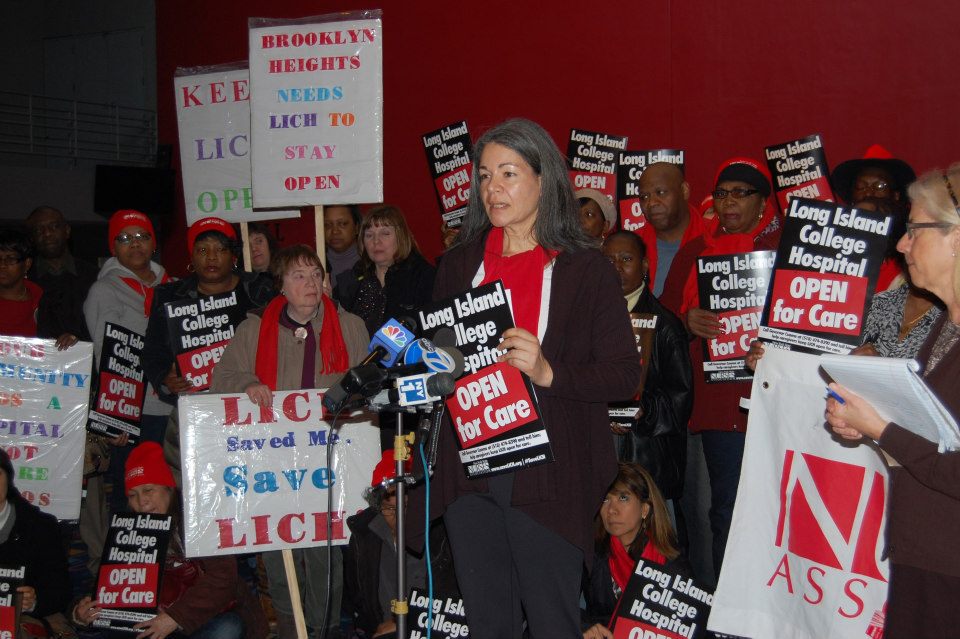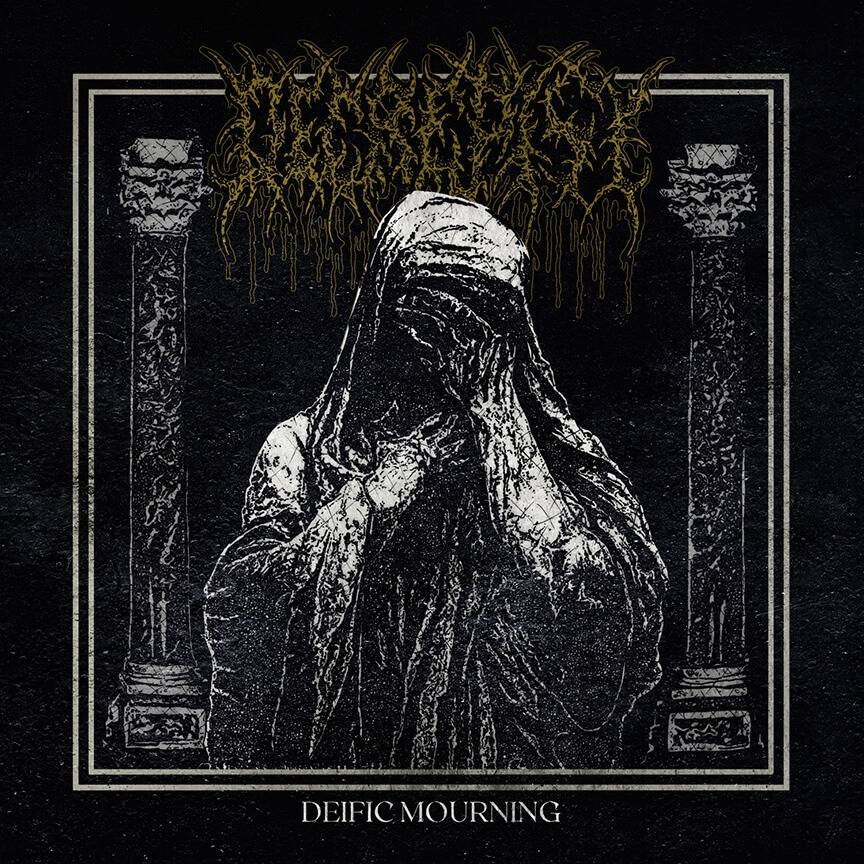Despite last week’s unanimous vote by the State University of New York (SUNY) Downstate to shut down Long Island College Hospital (LICH) and liquidate their assets to pay down a significant portion of their own debt, hospital workers remain resilient and determined.

SUNY doesn’t have the power to close the hospital; only the Department of Health (DOH) has the authority to close a public medical facility. LICH’s existence lies squarely on the state’s shoulders. Until then, hospital employees maintain they will continue operating the hospital as usual. “LICH IS OPEN FOR CARE,” they proclaim at rallies, forums and candlelit vigils – even in the offices of DOH.
Julie Semente, a registered nurse for the past 30 years in LICH’s ICU, says: “SUNY’s actions over the past 2 months have stunned everyone. Lying about LICH real estate not being a factor in the closure decision while railroading through the process illegally was bad enough. Now shutting the community out of the process by holding a public hearing for LICH in Westchester is just making Downstate appear even less credible. But the community’s anger is going to fall on top of Governor Cuomo. All of the SUNY Trustees except for the student representative, are the governors appointees. From Red Hook to Brooklyn Heights to Dumbo, people won’t forget that their only hospital was closed and their lives were put at risk while under Cuomo’s watch.”
In 2012, LICH served more than 100,000 patients, admitted over 58,000 people to through the emergency room and delivered 2,000 babies. Sixty-six of their physicians in thirty-five specialties were ranked among the best in the nation. Services in pulmonary (lung), nephrology (liver), neurology (nervous system), and neurosurgery (brain surgery) are ranked among the top in the nation.
LICH provides emergency, primary and mental health care for a wide-ranging number of citizens from all socio-economic levels. They are also a designated stroke, cardiac angioplasty and neurological and neurosurgical center.
LICH began in 1858 as a medical school and a hospital. LICH started having relatively small annual deficits around the mid 1990’s. The Board of LICH opted to take on an outside partner to maximize their cost efficiency, according to Toomas M. Sorra, MD and President of Concerned Physicians of LICH. They eventually merged with Continuum Health Partners in 1998.
LICH had never faced closure before being “plundered by Continuum,” she said. But in 2008, Continuum sold off approximately $50 million worth of properties for real estate development.
After a decade of mismanagement from 1998-2008, Continuum sent warning notices to the employees of LICH, planning to discontinue women and children’s services as well as dental services. DOH refused to allow it because the services were vital to the surrounding communities.
“Nothing has changed since then, except that the population of the community we serve has exploded. If LICH was too vital in 2008 to shut down even just a few services, it’s even more vital now,” wrote Semente.
Continuum then filed formal complaints in 2008 with the State Health Department to terminate their partnership with LICH.
Continuum was also aligned with St Vincent’s in Manhattan when their doors were permanently shuttered. St Vincent’s was over $1 billion in debt and they were forced to close in 2010.
The state awarded SUNY Downstate a $40 million grant in October 2010 to acquire and operate LICH, making the hospital a secondary campus for SUNY.
In an October 14, 2010 press release from former Governor David A. Paterson, he said, “One of our main health care goals is to ensure that all New Yorkers have access to high quality care in their communities. The HEAL [Healthcare Efficiency and Affordability Law for New Yorkers] grant is an important investment in the future of healthcare in Brooklyn and will allow SUNY Downstate to create another campus to better serve local residents and continue to train the next generation of physicians.”
In October 2010, John C. LaRosa, then President of SUNY Downstate said, “This agreement will also strengthen Downstate’s education and training mission, and preserve Downstate’s standing as the hub of medical education in Brooklyn. Equally important, critically needed healthcare services in Brooklyn will be safeguarded.”
On May 29, 2011, SUNY purchased 18 separate LICH properties for$205,350,000.
In June 2012, LaRosa, who had been president of the hospital for 13 years, unexpectedly resigned, right around the time that SUNY’s fiscal year ended and the Comptroller began their annual audit. LaRosa was replaced by Dr. John Williams who was formerly the president of Verras Health Care International, a hospital consulting firm.
The following timeline summarizes major LICH developments since that time:
- January 17 – NYS Comptroller, Thomas D. Napoli released an audit showing the fiscal crisis of all of SUNY Downstate including LICH. “The Hospital [SUNY] is facing potential insolvency within a matter of months… experiencing cash deficiencies of approximately $3 million every week.”
- January 17 – SUNY Chancellor, Nancy L. Zimpher issued a press release regarding the audit.
“Many of the Comptroller’s findings – none of which we dispute of consider to be a surprise – are issues already remedied or currently being addressed at Downstate. SUNY System Administration has recruited a strong new leadership team at Downstate that is developing a comprehensive, fiscally responsible plan to ensure medical education and quality healthcare continues for the people of Brooklyn.”
- February 1 – Carl McCall responded to a letter sent by elected officials on January 24, 2013. He provided a list of reasons for the fiscal crisis, including, “the complexities of the State system that limits expeditious decision making and action by SUNY hospitals, including procurement, contracts, capital projects, and state employment rules. “
“The Chancellor and the State University Board of Trustees have requested that the newly appointed leadership team at Downstate provide recommendations for immediate action to mitigate losses, one of which was the possible cessation of operating LICH as a full service inpatient hospital.”
- February 7 – SUNY held a Board of Trustees meeting at the College of Optometry in Manhattan
- The meeting was announced on February 4, only 3 days prior.
- Those wishing to speak had to first register for a time slot as well as announce the subject of their comments by Wednesday February 6 at noon and were allotted 3 minutes each.
- February 7 – Crain’s published an article entitled, “Downstate Wants New Hospital”
- “SUNY Downstate executives want to build a brand-new hospital to replace crumbling University Hospital, funded by the proceeds of selling Long Island College Hospital.”
- “The brazen scheme is highly speculative, given that it requires both state approval of LICH’s closure as well as the state’s blessing of a new hospital.”
- ” The new hospital would be privatized.”
- February 8 – Board of Trustees of SUNY Downstate voted unanimously to close LICH
- February 8 – Jeff Strabone, former president of the Cobble Hill Association (CHA), proposed to change the zoning at LICH.
- February 14 – Less than one week after the vote, unions, neighborhood assemblies elected officials and supporters held a rally that was attended by hundreds at the Kane Street Synagogue
- February 18 – CHA met with Councilman Brad Lander to discuss zoning changes.
- February 20 – New York State Nurses Association, 1199 SEIU United Healthcare Workers East, Concerned Physicians of LICH, LLC and Kathleen Campbell Petitioners filed a lawsuit against SUNY and their trustees.
- Kings County Supreme Court Justice, Judge Betsy Barros issues a temporary restraining order preventing SUNY from implementing their February 8th decision or communicating such intent to DOH
- February 25 – Lander, Markowitz and other elected officials request that the Department of City extend the Cobble Hill Historic District’s 50 foot height limit to LICH, as proposed by CHA, “in order to prevent out-of-context development.”
- February 28 – The Brooklyn Heights Association sent a letter to Governor Cuomo stating, “Let’s be clear, the Berger Work Group, appointed by Health Commissioner Shah, did not recommend closing LICH. On the contrary, when it issued its report on Brooklyn health care in 2011, it advised Downstate to consider consolidating all Downstate inpatient services at LICH.
- February 28 – The Brooklyn Paper published an article entitled “LICH-EROO! State wanted to save hospital before killing it.”
- ” The university told the state comptroller that the deal was better than it looked on paper because Long Island College Hospital’s prime Cobble Hill land could be worth as much as $500 million,” the article read.
- State University spokesperson, Robert Bellafiore was quoted several times in the article, saying, “The fact of the matter is that zero consideration has been given to the real estate factor of it. It is so cart before the horse, it’s not even funny.”
- The stark juxtaposition of the two opposing facts created a flurry of comments among the readers. “Bob from Brooklyn” wrote, “If SUNY in fact valued LICH property at $500 million AT THE TIME OF ACQUISITION … well, that sort of belies SUNY’s recent assertion that the value of LICH’s real estate was never even considered.” Another commenter, “allen” wrote, “bob [sic], you caught that too? methinks they had an unintentional slip of the tongue.”
- Thursday, February 28 – A Power Point presentation was posted on the SUNY Board of Trustees website entitled “A Future for Downstate Medical Center.” On page 4 of this document, SUNY explains their three-stage plan
Phase 1 – Secure $150 million in Stability Funds from New York State.
$150 million is needed to keep the operation going and support mission critical items, while we work to fix many of the underlying problems that contribute to these losses.
Phase 2 – Restructure the Operation for Sustainability
a) Proceed with the restructuring of the operation of Downstate Medical Center.
b) Cease inpatient operations at LICH. The operating losses are significant and assumptions for the acquisition, particularly related to patient volume, were significantly flawed.
c) Pursue legislation which will increase the flexibility of the organization to support a more financially sustainable operation.
Phase 3 – Pursue a Brooklyn Solution and Long-Term Sustainability for
Downstate Medical Center
Develop a plan for creating a Brooklyn hospital consortium, including significant affiliations and partnerships that will serve to make Downstate Medical School the medical school for hospitals in Brooklyn. Explore the potential of the consortium to develop a new hospital for central/northern Brooklyn
- March 1 – One day after the previous post, another Power Point Presentation was posted entitled “SUNY Hospitals & A Healthier New York: Capital Briefing.” Page 14 listed the outstanding debt of their hospitals as of January 31, 2013:
- Upstate: $187,542,000
- Downstate: $191,329,000
- Stony Brook: $251,818,000
- March 8 – Brooklyn Supreme Court Judge Johnny Lee Baynes extends the temporary restraining order against SUNY
- March 12 – Nurses delivered almost 30 pounds of petitions to Dr. Nirav Shah, Commissioner for the Department of Health. They turned the event into a rally, waiving their iconic signs and chanting their consistent message. “LICH IS OPEN FOR CARE!”
- March 14 – Brooklyn Supreme Court Judge Johnny Lee Baynes voided the February 8 vote because SUNY violated the Open Meetings Law.
- March 14 – The Brooklyn Paper reports that SUNY did discuss LICH as real estate.
- “State officials justified their controversial move to make a public meeting private by confessing they were discussing the hospital’s $500-million property holdings in secret one day before announcing the plan to shutter LICH, according to legal documents.”
- “Among other topics, attendees of the closed-door meeting talked about ‘the proposed sale of LICH realty title,’ said one affidavit, filed by Lora Lefebvre, the university’s associate vice chancellor for health affairs. That is quite a reversal.”
- March 15 – State Assemblywoman Joan Millman, and State Senators Daniel Squadron and Velmanette Montgomery sent Cuomo a letter requesting the shutdown be halted until the Empire Development Corporation could conduct a study on the economic impact of the closing.
- March 19 – SUNY votes unanimously for a second time to close LICH
- The vote was held in Purchase, New York – nearly 40 miles away from the facility.
- LICH workers organized and bussed over 100 workers and community members to the hearing.
- Squadron released a statement saying, “SUNY again demonstrated a disturbing lack of transparency, holding its vote on the future of LICH in Westchester. But still we made our voices heard – for our community and for Brooklyn.” Squadron also noted that the location of the hearing was a “slap in the face to all those impacted.”
- In response to the accusation that the vote had been scheduled upstate to discourage supporters of LICH to attend, Board Chairman Carl McCall claimed the meeting had been scheduled months in advance. However, SUNY only knew five days prior to this second vote that they would have to reschedule the hearing and revote on the issue.
- March 20 – Caregivers held a candle light vigil and march through Brooklyn Heights after SUNY’s unanimous vote to close LICH, “to remind community that we are still here,” said Semente.
- March 21 – LICH employees receive WARN notices, or notices of termination, effective June 18, 2013 – exactly 90 days after the vote, the time limit mandated by the state before a proposed closure. The letters were postmarked on Wednesday, March 19, suggesting that they were already prepared to mail out the day of SUNY’s second vote to terminate LICH.
- March 21 – Caregivers met with senior community group in Gowanus and Red Hook to raise awareness.
- March 23 – Caregivers will participate at 12 pm meeting at Borough Hall that Marty Markowitz has called to address the issue.
- March 23 – Caregivers will attend the Civic Association meeting to raise awareness in the Red Hook community at PS 15 at 7 pm.
- March 28 – caregivers will hold a forum for the Red Hook community at 6:30 pm at PS 15.
For now, LICH as they say is still “open for care.” Hospital workers and community members are fighting side by side on a daily basis to keep it that way. Ironically, the very lives that LICH has saved time and again may be the same ones that save the existence of the hospital.
” We are not afraid of termination letters,” Semente says. ” We have confidence that the Department of Health will recognize its responsibility to the care of the community.”
Downtown Brooklyn may face many unnecessary challenges with the loss of LICH. In a 2008 interview with the NY Times, Judy Stanton, former executive director of Brooklyn Heights Association states quite clearly the importance of LICH’s survival. “If your child was having an asthma attack, and you couldn’t rush to LICH where there are pediatric specialists to give the right dose, then yes, your child could die.”
Note: this is an abridged story that appears in the current issue of the Red Hook Star-Revue. To read the whole thing, see the complete paper at www.redhookstar.com










One Comment
excellent reporting by the red hook star. thank you!